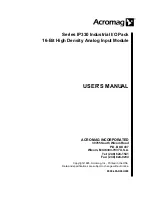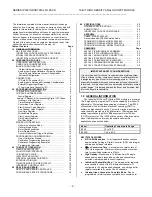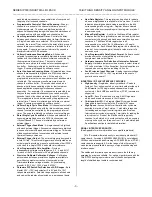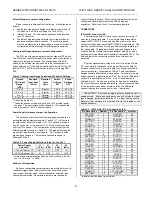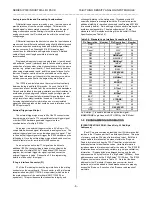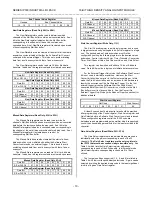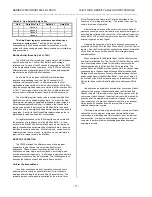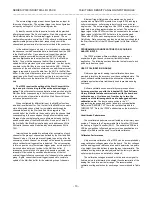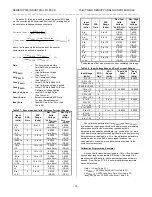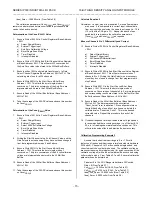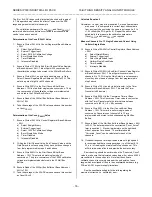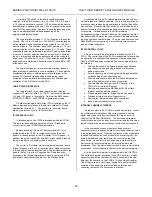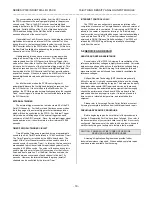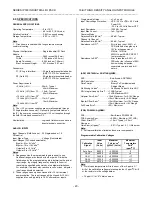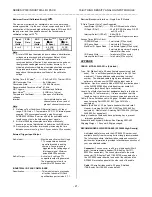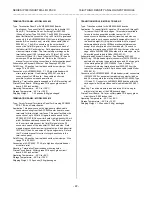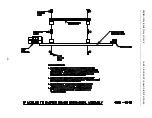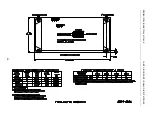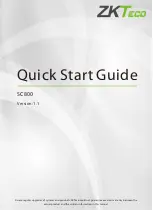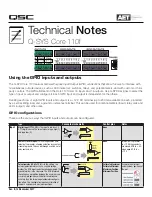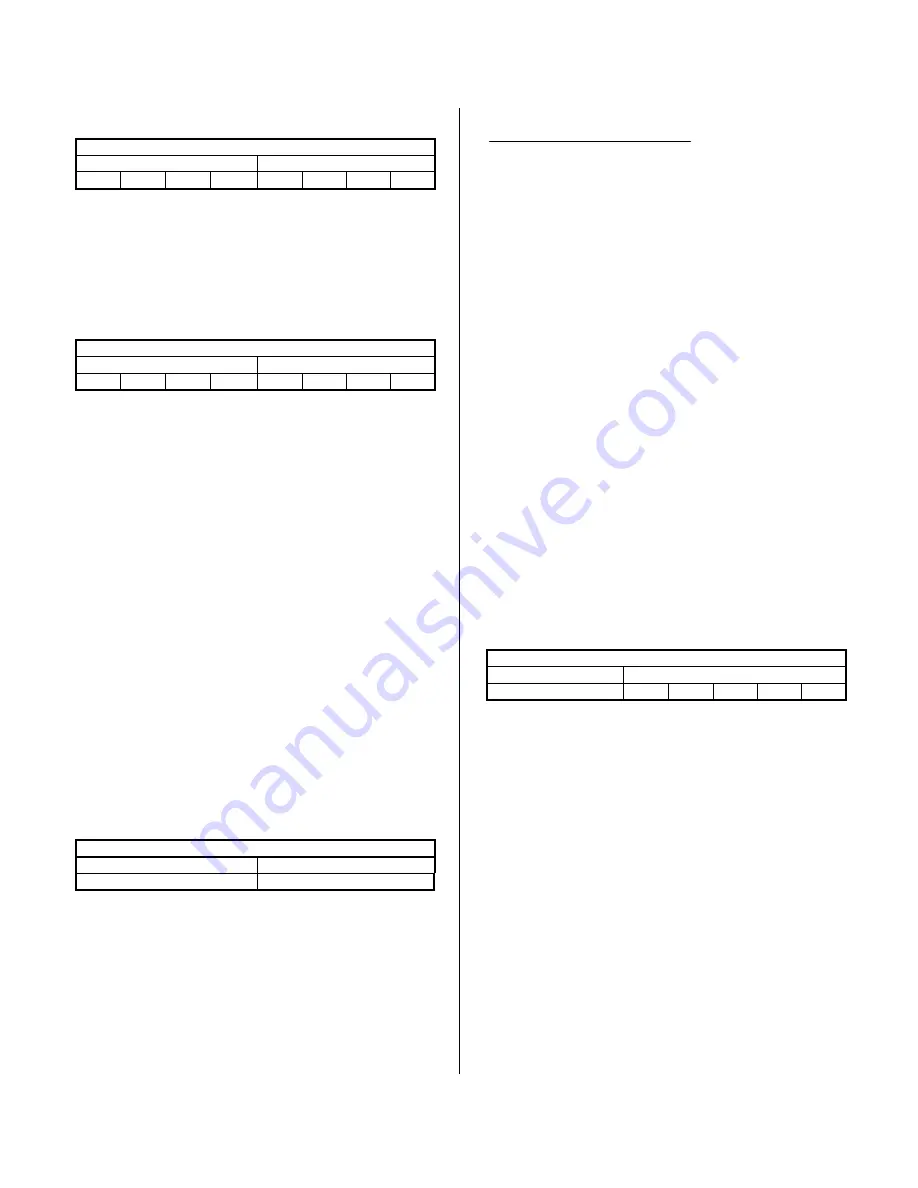
SERIES IP330 INDUSTRIAL I/O PACK 16-BIT HIGH DENSITY ANALOG INPUT MODULE
___________________________________________________________________________________________
- 9 -
Interrupt Vector Register
MSB LSB
07 06 05 04 03 02 01 00
Interrupts are released on an interrupt acknowledge cycle.
Read of the interrupt vector during an interrupt acknowledge cycle
signals the IP330 to remove its interrupt request.
Timer Prescaler Register (Read/Write, 02H)
The Timer Prescaler register can be written with an 8-bit value
to control the interval time between conversions.
Timer Prescaler Register
MSB LSB
15 14 13 12 11 10 09 08
This 8-bit number divides an 8 MHz clock signal. The clock
signal is further divided by the number held in the Conversion
Timer Register. The resulting frequency can be used to generate
periodic triggers for precisely timed intervals between conversions.
The Timer Prescaler has a minimum allowed value
restriction of 40 hex or 64 decimal.
A Timer Prescaler value of
less then 64 (decimal) will result in an empty Mail Box Register
buffer. This minimum value corresponds to a conversion interval
of 8
µ
seconds which translates to the maximum conversion rate of
125KHz. Although the board will operate at the 125KHz
conversion rate, conversion accuracy will be sacrificed.
The formula used to calculate and determine the desired
Timer Prescaler value is given in the Conversion Timer section
which immediately follows this section.
Read or writing to this register is possible via 16-bit or 8-bit
data transfers. A 16-bit data transfer will implement simultaneous
access to the Interrupt Vector and Timer Prescaler registers. The
Timer Prescaler register contents are cleared upon reset.
Conversion Timer Register (Read/Write, 04H)
The Conversion Timer Register can be written to control the
interval time between conversions. Read or writing to this register
is possible with either 16-bit or 8-bit data transfers. This register’s
contents are cleared upon reset.
Conversion Timer Register
MSB LSB
15 14 13 12 11 10 09 08
07 06 05 04 03 02 01 00
This 16-bit number is the second divisor of an 8MHz. clock
signal and is used together with the Timer Prescaler Register to
derive the frequency of periodic triggers for precisely timed
intervals between conversions.
The interval time between conversion triggers is generated by
cascading two counters. The first counter, the Timer Prescaler, is
clocked by an 8MHz. clock signal. The output of this clock is input
to the second counter, the Conversion Timer, and the output is
used to generate periodic trigger pulses. The time period between
trigger pulses is described by the following equation:
Timer Prescaler Conversion Timer = T in seconds
∗
8
µ
Where:
T
= time period between trigger pulses in microseconds.
Timer Prescaler
can be any value between 64 and 255
decimal.
Conversion Timer
can be any value between 1 and
65,535 decimal.
The maximum period of time which can be programmed to
occur between conversions is (255
∗
65,535)
÷
8 = 2.0889
seconds. The minimum time interval which can be programmed to
occur is
(64
∗
1)
÷
8 = 8
µ
seconds. This minimum of 8
µ
seconds is defined
by the minimum conversion time of the hardware but does
sacrifice conversion accuracy. To achieve specified conversion
accuracy a minimum conversion time of 15
µ
seconds is
recommended (see the specification chapter for details regarding
accuracy).
Start Channel Value Register (Read/Write, 07H)
The Start Channel Value register can be written with a 5-bit
value to select the first channel that is to be converted once
conversions have been triggered. All channels between the start
and end channel values are converted. A single channel can be
selected by writing the desired channel value in both the Start and
End Channel Value registers.
The Start Channel Value register can be read or written with 8-
bit data transfers. In addition, the Start Channel Value register can
be simultaneously accessed with the End Channel Value via a 16-
bit data transfer. The unused bits are zero when read. The
register contents are cleared upon reset.
Start Channel Value Register
Unused
Start Channel Value
07 06 05
04
03
02
01
00
After running data conversions are halted, the internal
hardware pointers are reinitialized to the start channel value. Thus
when conversions are started again, the first channel converted is
defined by the Start Channel Value register.
End Channel Value Register (Read/Write, 06H)
The End Channel Value register can be written with a 5-bit
value to indicate the last channel in a sequence to be converted.
When scanning, all channels between and including the start and
end channels are converted. A single channel can be selected by
writing the desired channel value in both the Start and End
Channel Value registers.
The End Channel Value register can be read or written with 8-
bit data transfers. In addition, the End Channel Value register can
be simultaneously accessed with the Start Channel Value with a
16-bit data transfer. The unused data bits are zero when read.
The register contents are cleared upon reset.

